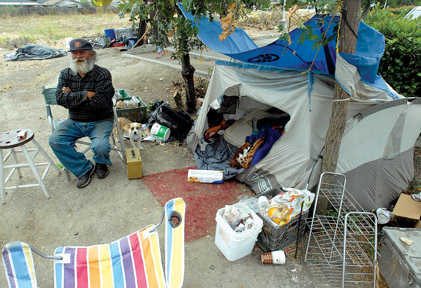San Benito County received word last week that it will be getting $500,000 in community development block grant funding after a state snafu almost dubbed the jurisdiction’s application ineligible in May.
Though San Benito County’s application to provide funds to an emergency winter shelter, the Emmaus House domestic violence shelter, as well as job training services, was awarded, the City of Hollister’s application was not successful this go around.
“I was very confident,” said Enrique Arreola, the deputy director of San Benito County’s Community Services and Workforce Development department. “We submitted a darn good application, and second of all, we know the need in San Benito County is enormous.”
The City of Hollister had been ineligible to apply for CDBG grants for several years, but this year submitted an application. Its application included requests for $1.2 million in CDBG funds to be used toward housing assistance, down payment assistance, the Community Food Bank, the Youth Alliance and Jovenes de Antano.
The applications were filed in March, when the waiting game began to find out which of the 96 agencies from the state who submitted applications would receive funding. But in May, San Benito County and Hollister city officials received a letter from the state’s department of Housing and Urban Development, which oversees the disbursement of the federal funds, saying their applications were ineligible.
The confusion came over a change in the requirement of where counties and cities have to send audit reports. San Benito had submitted it to the federal clearninghouse, which then forwards the report to the state controller’s office, but the state’s Housing and Urban Development HUD said it should also have been sent directly to the state controller’s office.
The supervisors and city officials both got state and federal representatives involved in their plea to have their denials reviewed.
The state controller’s office looked into the issue in May and determined that 15 of the 22 applications that had been denied had actually met the requirements, including San Benito County and Hollister.
“Honestly, without that process, I don’t think any of us would have been considered,” Arreola said. “If no one made noise or questioned it, met and talked to the state department, no one would have made a buzz at it.”
While the funds for the CDBG have not been disbursed yet, Arreola said one of the new changes this year is that agencies will have to spend at least 50 percent of the funding they receive for 2012 before they can submit an application for 2013 funding, generally due in early spring.
“If we don’t spend half our money by the time the application is due, we are not eligible,” he said. “If everything falls in order, we should spend at least 50 percent. The services are in full ramp during this time.”
He noted that Emmaus House and job-training programs are already in place so there won’t be a long lead time before they start incurring costs. The emergency winter shelter starts up in November, when it will start incurring operational costs. Arreola said he told the board of supervisors about the new rule when he submitted the application, but he will talk with them again at a future meeting.
In deciding types of projects to fund, Arreola said the Community Action Board members conduct a survey of community members on what they thing are the greatest needs. From there, the board takes project submissions from nonprofits and agencies in the county. Once the notice of funding availability is sent out by the HUD office, the CAB members decide on what applications to move forward based on the eligibility requirements of the state as well as the issues considered important in the community.
“The survey has 15 different areas and ranks the needs,” Arreola said.
Job placement and training and youth ranked high in the survey. The state requirements also mandate that the services target low-income or very low-income residents, with the homeless as one of the special populations that is targeted for services.
The county had originally selected five projects, but narrowed it to three when the state application said each jurisdiction could only apply for three areas of funding.
“I’m just very excited that the CAB and the state approved the application and these types of services in my opinion are so critical, especially workforce services,” Arreola said. “If you get them (residents) training in high-growth career occupations where they are placed in a job, they become self-sufficient.”
City Manager Clint Quilter did not return requests for comment before deadline.
75.4
F
Hollister
May 12, 2024







